Luminous pigment when mixed ready to use is very peculiar stuff with some strange characteristics, so expect to take a while to master the basics of working with it.
If you’re really determined to try for yourself,
DO NOT THINK OF STARTING IMMEDIATELY ON A REAL DIAL!
PRACTICE, PRACTICE, PRACTICE.
As most of us don’t have a box of old dials lying around, get something like thin sheet brass, cut out a few dial size circles, paint them black and then use them to practice on. Just keep cleaning them back to metal with thinners and doing it over again.
As SuperLuminova is VERY expensive to use for practice pieces, I’d suggest starting with some of the inexpensive pigment from someone like Glow Inc. (or if you’re in the EU you can get similar pigments from RRWP or SatinTime). Start with the easiest to use, small grain particle pigment, that’s the V10 5-15 micron that costs just over $20 an ounce from Glow Inc.(that’s loads in watch quantities). Then you could start with some artists acrylic painting medium from your local craft store to use as the binder or any good clear art varnish that has no UV filtering. But the binder characteristics is possibly the main thing you need to learn, so do try to get a proper one (A100 from Tritec or Binder 3 from Noctilumina are good general purpose ones), along with the matching thinner/dilutor. By all means get some C3 or G8UF while ordering the binder, just don’t waste it on practice pieces unless you have money to burn. Expect to redo the dummy dials a good few times before you get a feel for it and are anywhere near ready to try a proper dial. Just practice doing dots, squares, rectangles and straight lines for a while, then try doing numerals freehand.
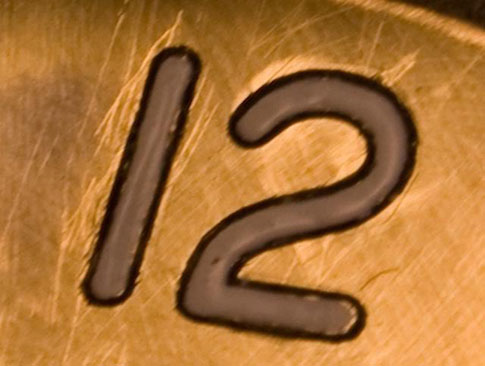
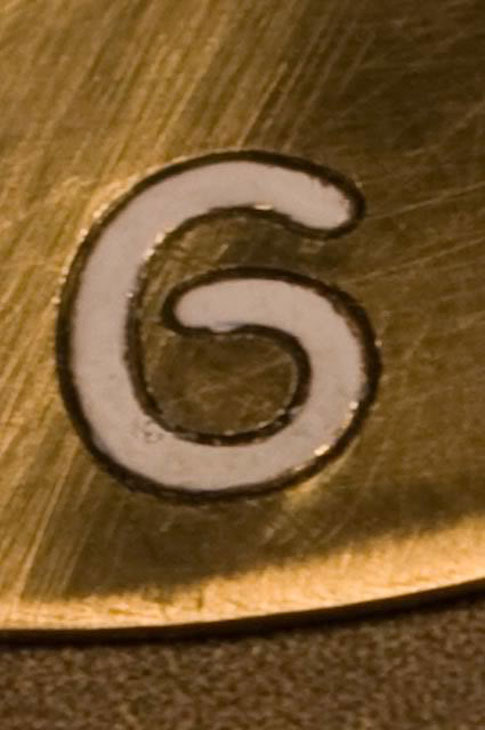
(Practice pieces from a trainee)
You need to learn what applicator tools suit you best, what to mix in, what different mix ratios do, how thick you need to let the mix get for different effects, how to keep it at that thickness, how to get it to flow over the hole in hands without falling through and how to make it glow evenly when dry without light or dark patches.
So;Applicators
The most common is the watch oiler.
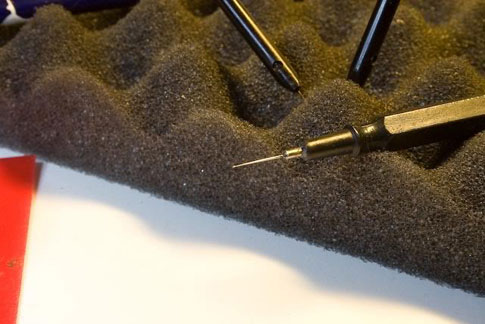
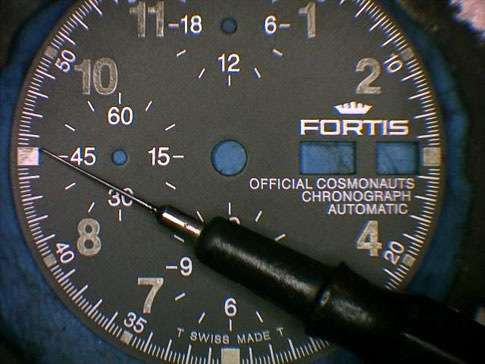
Any fine tipped tool can be used, even a pin, but it should have a smooth finish to encourage an even flow of lume onto the work-piece.
I use a variety of tools, including modified oilers, fine technical drawing pens, ‘colour shaper’ type silicon brushes and extra fine scalpels for controlling straight lines on awkward work.
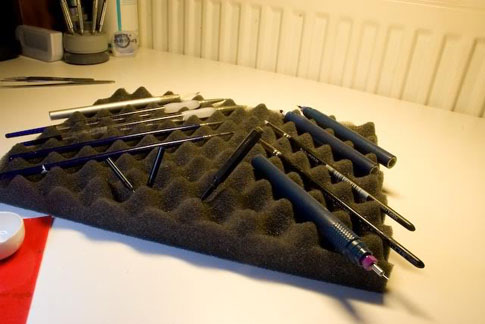
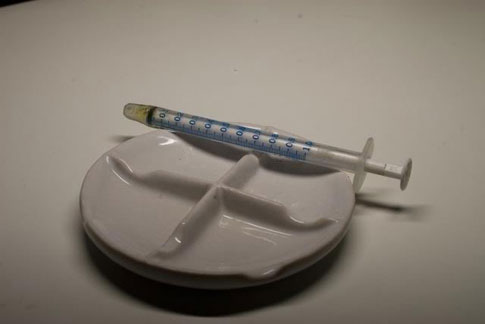
The sloping surface provides a great advantage in that you can better control the size of the bead of lume you pick-up by touching your applicator down in the ‘shallow end’, or the ‘deep end’, or anywhere between.
The most typical mix ratio is 1:1 pigment to binder by volume. Dedicate a small screwdriver or similar small flat bladed tool to use as your pigment scoop and measure, wiping clean thoroughly between uses. For the binder, you should try to use a small medicine syringe or a bulb pipette dropper to pick up and deliver your binder to the mix, and add by counting drops. This will help you developing a method for getting consistent mixing ratios. Mix ratios higher in binder will give a glossier finish and conversely high pigment to binder ratios will be matt finish. If you’re mixing your own blend of grain sizes (read back in Part One – The Theory to find out why you might want to), mix the powder thoroughly – really thoroughly, before adding the binder and if desired, grind the particles slightly as you mix to make it even more of a blend of sizes. Mixing is usually done with a small glass rod, such as the ones supplied in lume kits or, the silicon rubber ‘brushes’ known as colour shapers work well. Whatever you use, be prepared to keep stirring the mix throughout use to keep the particles evenly distributed within the binder, it also helps keeps the mix fluid.
Play around with these mix ratios and get a feel for how it affects application, colour, brightness and duration of glow. You can then fine tune the mixture with dilutor to increase flow, enable thinner applications (often useful if you want to do a multi-coat application) and then to extend the working life of the mix. In use, over time you will notice that the mix starts to get ‘stringy’ and, particularly if you’re using a blend of particle sizes, will get noticeably more grainy. This is when you need to add a tiny amount of dilutor at a time, and remix thoroughly. You may well need to wait a little while for the mix to start setting up again to where you want it. I always test by applying a drop on a piece of scrap after diluting to ensure it isn’t going to flow too much and get onto the dial surface and ruin it.
Luming Dials
Wherever possible apply the lume to a smooth, bright white base coat. It makes a huge difference to the colour and effectiveness of the lume.
Sandwich dials might seem easy as you’re not having to be exact, but be aware of a few issues before you try one. When splitting the dial halves, ensure both halves stay perfectly flat, the slightest bend could make the dial unusable. When applying the lume, don’t put too much on, if it’s even the tiniest bit too high the dial wont seat back together properly.
If the dial does get slightly bent or the two halves don’t mate back correctly, chances are that the dial will be too thick or flex slightly and either the second hand won’t go back on – or – it seems all right but falls off later because the dial flex pushes it off. By the way, it’s a common misconception that sandwich dials glow the brightest. Not in my experience. A sausage dial will typically have a greater lume area available to the light and so take on a better charge. The lume on a sandwich dial is at the bottom of a hole remember. The easiest dials to start with are the ones with simple dot hour markers. Dials with applied markers are ok but have very little room to add more lume without it overflowing the recess, so really benefit from removal of the old lume, and this needs to be done very carefully, on reps especially, as the markers are usually chromed plastic and will scratch very easily, or worse snap off from the dial if you get a bit heavy handed. Sausage dials and dials with lumed numbers need a bit of skill to develop before you try them.
Warning! Dial surface finish marks very easily. Anything that will come into contact with the dial (cloth, tissue, brush, Rub-Off, whatever) must also be absolutely clean to minimise the danger of marking the dial. You will need some A&F Rub-Off or Rodico (they do work differently so try both and see what you prefer) for dial cleaning before you start and you must ensure you’re working in as clean an environment as you can manage. You should also try to get an idea of what the existing dial finish is and how it will react to your lume binder if it does come in contact. Some are fairly friendly and will allow quick, minor adjustments to a straight edge for example without softening too much and marking or ruining the dial surface. If there’s the slightest amount on the back of the dial, test it there. If you can’t test, assume the worst and keep well within the markers. Also be aware that the applied lume will be softening the surface below it, try your best not to touch the dial surface with the tip of your applicator, especially if you are going back over an area. It’s one of the quickest ways of ruining a lume job. The skill is to just touch the edge of the bead of lume on your applicator to a central point on the part you are putting the lume on and then controlling the flow from applicator to dial by the height and speed of movement of the applicator bead. The slower you go, the more lume will flow to a given area. The lower you go, the wider the contact point of the bead will be.
Holding and working on the dial
You will need to secure the dial to something to allow you to freely move the dial around without touching it and that will protect the dial feet from damage. I use an old, cheap plastic, three hole oil pot with a lump of Rub-Off on top to secure the dial.
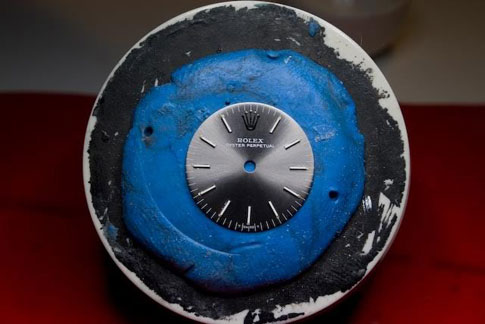
A lot of your choice will be dictated by your work table height and what you’re using for magnification. A typical loupe will mean that you need the dial 1-2″ away from your eye and you will probably need something tall to raise the dial for working, as very few desks are that high and you don’t want to spend too long hunched over. But at the same time, ideally, you should try and get a working position where your forearms are supported flat on the desk. This makes a huge difference in how steady your hands will be.
I use a stereo zoom microscope on a long reach arm to allow me to work at high magnifications for longer periods with a comfortable working distance between the objectives and the workpiece, but that’s a luxury only justified if it’s paying back it’s purchase price. My ‘scope also has a very bright, adjustable LED ringlight to illuminate the dial.
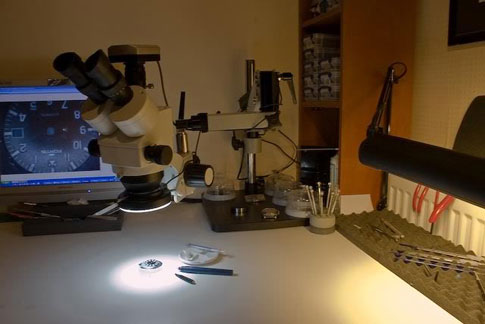
The three things you will really need to get if you want good results are:-
• A good magnifier or loupe. I’d suggest that a 7x is a minimum, a 10x and a 20x is ideal.
• A good light. This will make a huge difference to your work. A two or three tube, daylight balanced work lamp is the kind of thing you should be looking for. • A dust cover. Whenever you put the dial down, you should put a cover over it to prevent dust falling on it and sticking to the wet lume. A small drinking glass, plastic cup or anything like that will do the job, as long as it is spotlessly clean itself.
Applying the lume to the dial
Other than doing a video, it’s difficult to actually demonstrate lume going down onto a dial, so the best I can do is offer some tricks and tips. • Pick up the right size bead of lume for the size of the detail you’re applying it to. Too much and it will flow over the edge of where you want it. Too little and you’ll spend forever applying little tiny dots that will make straight lines difficult and will probably take so long that you will keep loosing a ‘wet edge’ to flow the next bead into, leaving a very lumpy finish. Your goal is to pick up just enough to pull a bead of lume along the marker you are luming as far as you can in one go, without having so much that you will be running into the danger of bits of lume blobbing outside the area you want to cover. • If you’re trying for a really strong lume, try putting a first application on with a higher mix of large particle size pigment, but leave enough room for a second, top coat, where you use just fine grain particles and make a thin, glossy mix to put over the top as a finishing surface. • Keep a piece of pith wood handy for sticking your applicator into frequently to keep it clean. • Keep moving the dial holder around to permit your hand motion to be in its most natural direction. But be extra careful that your hand doesn’t then smudge anything you’ve already lumed. 👿 • Avoid caffeine. Yes really! Caffeine jitters might not normally be noticeable but when you are dealing with this kind of fine control it makes a difference. You may well also find that you are better able to do steady work at a particular time of day, for me it’s the late evening when I’ve unwound and relaxed.
• Give your hand/eye coordination time to adapt. Working at high magnification, you should find that after a little while your brain adapts and will allow much finer control over your hand movement to fit in with the scale of what you are viewing.
Additional Notes
Self-luminous compounds
Self-luminous compounds provide permanent legibility over a long period of time without any prior activation from an external light source. The energy release of a radioactive isotopes decay is continuously converted into a weak light emission. With tritium for example, traces of a solid, tritiated polymer are coated on zinc sulphide crystals to act as a permanent energy source, only limited by the active life of the element. The first widely used self-luminous compound used to provide a glow in the dark feature was radium (hence the ‘Radiomir’ from Panerai). This radioactive isotope was used to excite zinc sulphide crystals to make them glow in the dark. Once the radioactivity dangers (radium has a half-life of 1600 years) – particularly to the workers applying the compound – were fully realised by the 1950’s, new self-luminous compounds using either the radioactive isotope of hydrogen, tritium, or a man-made radioactive element promethium, were developed and totally replaced the use of Radium. Promethium based lume was known as N-Lume after its developer Nemoto of Japan, but with a half-life of around three years, it’s use was as short lived as it’s effective life. Tritium has a half-life of 12 years and this eventually became a major drawback, as it’s ability to glow diminished visibly within a few years. Tritium is also used in nuclear fission and so the regulations that came in to control the import, export and storage of radioactive compounds made it’s widespread use more and more difficult. Tritium lume is still available from Tritec but under very strict regulations. This lead to the research that developed the phosphorescent rare earth based compounds, again led by Nemoto.
Phosphorescent compounds
Phosphorescent compounds need activating or ‘exciting’ by an external energy source for them to glow. The first widely used phosphorescent pigment was Zinc Sulphide in the 1970’s.* Compared with the current compounds it’s not very bright and it only glows for a short time. Current compounds such as Luminova and SuperLuminova use Alkaline Earth Metal Aluminate compounds often just referred to as Strontium Aluminate, although that’s just one of the many variations used. Depending on the individual product, earth metals can include Strontium, Magnesium, Calcium, and Barium.* Silicon and Titanium can also be present.* The metal element is typically doped with Europium, the most reactive of the rare earth elements. These compounds do still have drawbacks. zinc sulphide decays over time in natural light, and the strontium aluminate type products degrade rapidly in the presence of water or moisture. As well as the gradual decay, this also limits the range of binders or mixing medium that can be used. To overcome this, some are available with the individual particles encapsulated in a plastic coating.
A recent development is the use of Crystal Fluoaluminate Compound. These are very stable crystals of oxides and halides of alkaline-earth and aluminum, doped with rare-earth elements. These have the advantage of not being affected by water exposure.
Grain Size
One of the key factors in how well a compound works is the size of the individual particles or grains. Smaller grains (<10 microns) are much easier to apply and give a smooth paint like finish but are less efficient. Large grains (75-100 microns) glow like a torch and will hold a charge for up to 36 hrs. So most manufacturers use varying blends of grain sizes to improve the performance. The larger particles improve the performance, while the smaller particles ‘fill the gaps’ between them, removing any ‘dead space’ and creating a smoother surface, so not as susceptible to micro shadowing reducing the effective charged area
